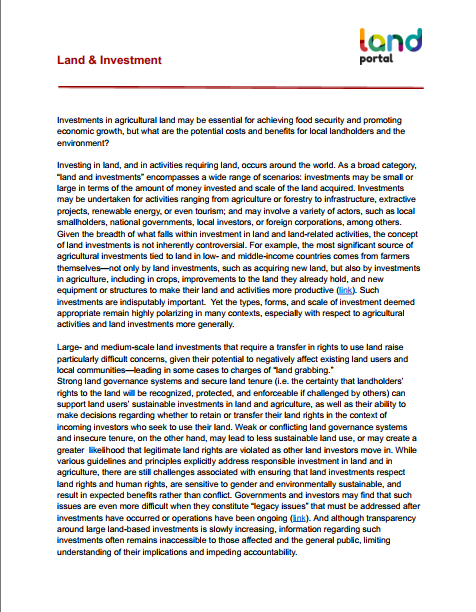Resource information
Investing in land, and in activities requiring land, occurs around the world. As a broad category, “land and investments” encompasses a wide range of scenarios: investments may be small or large in terms of the amount of money invested and scale of the land acquired. Investments may be undertaken for activities ranging from agriculture or forestry to infrastructure, extractive projects, renewable energy, or even tourism; and may involve a variety of actors, such as local smallholders, national governments, local investors, or foreign corporations, among others.
Given the breadth of what falls within investment in land and land-related activities, the concept of land investments is not inherently controversial. For example, the most significant source of agricultural investments tied to land in low- and middle-income countries comes from farmers themselves—not only by land investments, such as acquiring new land, but also by investments in agriculture, including in crops, improvements to the land they already hold, and new equipment or structures to make their land and activities more productive (link). Such investments are indisputably important. Yet the types, forms, and scale of investment deemed appropriate remain highly polarizing in many contexts, especially with respect to agricultural activities and land investments more generally.
Large- and medium-scale land investments that require a transfer in rights to use land raise particularly difficult concerns, given their potential to negatively affect existing land users and local communities—leading in some cases to charges of “land grabbing.”
Strong land governance systems and secure land tenure (i.e. the certainty that landholders’ rights to the land will be recognized, protected, and enforceable if challenged by others) can support land users’ sustainable investments in land and agriculture, as well as their ability to make decisions regarding whether to retain or transfer their land rights in the context of incoming investors who seek to use their land. Weak or conflicting land governance systems and insecure tenure, on the other hand, may lead to less sustainable land use, or may create a greater likelihood that legitimate land rights are violated as other land investors move in. While various guidelines and principles explicitly address responsible investment in land and in agriculture, there are still challenges associated with ensuring that land investments respect land rights and human rights, are sensitive to gender and environmentally sustainable, and result in expected benefits rather than conflict.Land & Investment
Governments and investors may find that such issues are even more difficult when they constitute “legacy issues” that must be addressed after investments have occurred or operations have been ongoing (link). And although transparency around large land-based investments is slowly increasing, information regarding such investments often remains inaccessible to those affected and the general public, limiting understanding of their implications and impeding accountability.

